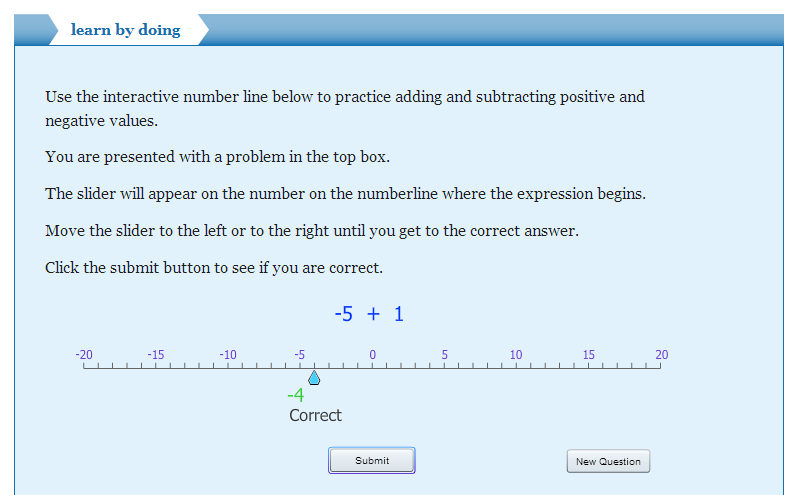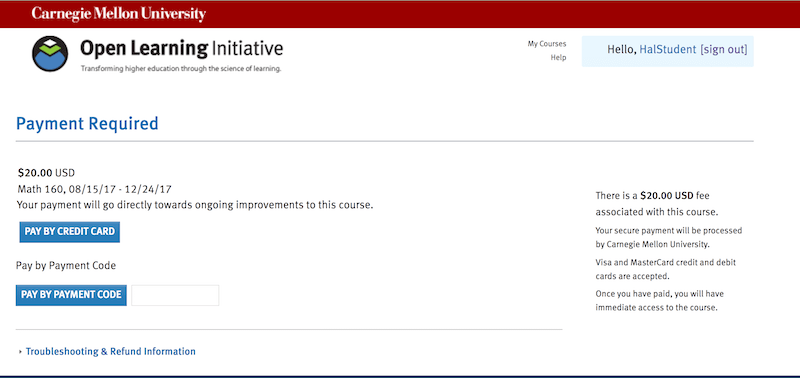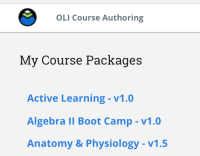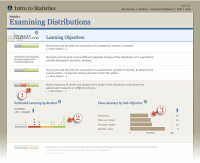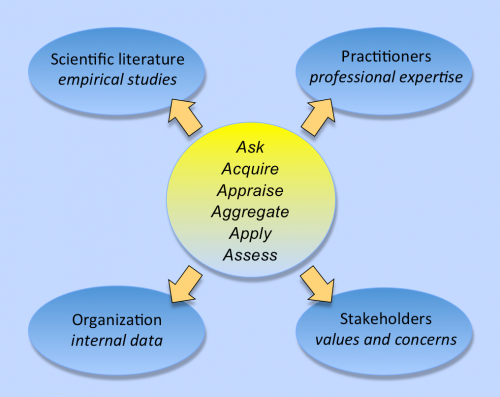This course provides a refresher of core skills related to STEM careers: Mathematics from arithmetic to beginning algebra, Workplace Communications and Professionalism. Students will be better prepared for success in post-secondary STEM related technical programs and ultimately in STEM related careers.
STEM Readiness
$25
- Description
- What students will learn
- Learning objectives by module
- Course assessments, activities, and outline
- Other course details
- System requirements
- Included instructor tools
Description
The STEM Readiness course provides a refresher of core skills related to STEM careers. The core skills covered are Mathematics from arithmetic to beginning algebra, Workplace Communications and Professionalism. The topics of the course are presented through workplace scenarios to show learners how these skills apply to their potential careers. In reviewing these core skills students will be better prepared to be successful in post-secondary STEM related technical programs and ultimately in STEM related careers.
Topics Covered:
- Mathematics
- Beginning and Intermediate Arithmetic
- Measuring Systems
- Data Analysis
- Beginning and Intermediate Algebra
- Triangles
- The Cartesian Plane
- Critical Thinking and Workplace Communications
- Written Communication
- Oral Communication
- Teamwork
- Evaluation and Reporting
- Troubleshooting
- Professional Skills
- Customer Service
- Confidentiality
- Organizational Skills and Time Management
- Teamwork
- Job Search
- Professional Image
What students will learn
Topics Covered:
- Mathematics
- Beginning and Intermediate Arithmetic
- Measuring Systems
- Data Analysis
- Beginning and Intermediate Algebra
- Triangles
- The Cartesian Plane
- Critical Thinking and Workplace Communications
- Written Communication
- Oral Communication
- Teamwork
- Evaluation and Reporting
- Troubleshooting
- Professional Skills
- Customer Service
- Confidentiality
- Organizational Skills and Time Management
- Teamwork
- Job Search
- Professional Image
Learning objectives by module
Unit 1: Mathematics
- Module 3: Beginning Arithmetic
- Apply arithmetic operations to problems involving negative values.
- Apply arithmetic operators to problems involving whole numbers and decimals.
- Apply critical thinking skills to larger, real-life situations and evaluate the outcomes.
- Define and recognize digits, place value, whole numbers, decimal points, and decimals.
- Identify which arithmetic operator to use in a given situation.
- Module 4: Intermediate Arithmetic
- Add and subtract like fractions.
- Add and subtract unlike fractions.
- Apply critical thinking skills to larger, real-life situations and evaluate the outcomes.
- Convert among fractions, decimals and percents.
- Convert given scenarios into algebraic expressions and equations.
- Explain what variables represent in an equation.
- Identify fractions as they relate to a given scenario.
- Multiply and divide fractions.
- Reduce a fraction to its simplest form.
- Round numbers to a specific place value.
- Module 5: Measuring Systems
- Apply critical thinking skills to larger, real-life situations and evaluate the outcomes.
- Calculate the area and perimeter of rectangles and squares.
- Calculate the circumference of circles.
- Calculate the perimeter of polygons.
- Calculate the volume of rectangular prisms.
- Convert between English standard units to metric units.
- Convert between English standard units.
- Convert between metric units.
- Identify common measuring tools for each measurement.
- Identify common units used for measurements.
- Identify significant digits in a value.
- Recognize various types of measurements (distance, time, temperature and weight).
- Module 6: Algebraic Laws
- Apply the distributive property to simplify or expand expressions.
- Calculate the volume of a cylinder.
- Calculate the volume of a sphere.
- Expand and multiply exponents.
- Express values using scientific notation.
- Simplify algebraic expressions by adding and subtracting common terms.
- Simplify expressions using the order of operations.
- Substitute known values into an equation and solve.
- Module 7: Quantifying Data
- Apply critical thinking skills to larger, real-life situations and evaluate the outcomes.
- Apply the steps for creating a line graph.
- Define mean, median and mode.
- Determine the mean of a data set.
- Determine the median and mode of a data set, given a data table.
- Identify types of charts, graphs and diagrams that are appropriate to use based on a given situation.
- Read and interpret charts, graphs and diagrams.
- Recognize different types of graphs and diagrams.
- Module 8: Beginning Algebra
- Rearrange an equation containing addition and subtraction to isolate a variable in one step.
- Rearrange an equation containing multiplication and division to isolate a variable in one step.
- Solve equations using the cross-product.
- Substitute known values into an equation and solve.
- Module 9: Triangles
- Apply the Pythagorean Theorem to calculate the length of a side of a right triangle.
- Calculate all angles and sides of a right triangle using trigonometry.
- Classify triangles by their angles as right, obtuse, or equilateral.
- Classify triangles by their sides as equilateral, isosceles, or scalene.
- Determine corresponding angles and sides of similar triangles, using proportions.
- Determine the measure of an angle by applying the concept of complementary or supplementary angles.
- Identify and name an angle.
- Identify corresponding sides and angles in similar triangles.
- Measure an angle using a protractor.
- Use the triangle angle sum theorem to determine the measure of an angle in a triangle.
- Module 10: The Cartesian Plane
- Calculate the distance between two points.
- Calculate the midpoint between two points on a line.
- Describe the layout and identify the quadrants of the Cartesian Coordinate System.
- Given a line on a graph, determine its slope.
- Given a linear equation, graph a line on the coordinate plane.
- Given a point on a graph, recognize whether an ordered pair is an x or y intercept.
- Given the coordinates of two points on a line, determine its linear equation.
- Given the coordinates of two points, determine the slope of a line using the slope formula.
- Given the point on a graph, determine the ordered pair.
- Graph points on the coordinate plane given an ordered pair.
- Visually identify whether the slope of a line is positive, negative, zero or undefined.
Unit 2: Critical Thinking and Workplace Communications
- Module 11: Introduction to Communications and Critical Thinking
- Analyze information from multiple sources to determine actions required in a given situation.
- Locate and interpret information from a chart or table.
- Locate and interpret key information from flowcharts and diagrams.
- Locate and interpret key information from text.
- Module 12: Oral and Written Communications
- Analyze information from multiple sources to determine actions required in a given situation.
- Compose effective email communications for various workplace scenarios.
- Demonstrate the ability to enter information correctly given a specific set of instructions.
- Describe the importance of filling in forms completely and accurately.
- Identify key components in an effective summary of information.
- Listen to a conversation and compose a summary of the information.
- Listen to a conversation and determine information needed to complete a summary of the call.
- Write a summary of a situation with all necessary components.
- Module 13: The Big Storm
- Apply critical thinking skills to real-life situations and evaluate the outcomes.
- Module 14: After Action Reporting
- Apply critical thinking skills to real-life situations and evaluate the outcomes.
- Compose a professional business memo.
- Describe appropriate public speaking guidelines.
- Determine most effective layout of information on slides for presentation.
- Write an effective purpose statement.
- Write an short essay using proper form.
- Module 15: Troubleshooting
- Apply the general troubleshooting process to situations.
- Module 16: Industrial Fire
- Apply critical thinking skills to real-life situations and evaluate the outcomes.
- Apply the general troubleshooting process to situations.
Unit 3: Professional Skills
- Module 17: Customer Service
- Determine most effective strategies or responses for various types of customer service situations.
- Identify various customer types based on common customer behaviors.
- Identify various types of employee behaviors that contribute to a customer’s positive or negative experience with the company.
- Recognize and explain the general principles of good customer service.
- Module 18: Confidentiality
- Define confidentiality and explain why it is important to maintain.
- Determine the appropriate action or response to take in order to maintain confidentiality in a variety of situations.
- Distinguish between appropriate and inappropriate responses to a breach in confidentiality.
- Identify common locations where confidential information is stored and transmitted.
- Identify the different ways that cybercriminals attack computers to steal information or ruin computer files.
- Identify types of information or data that is confidential.
- Recognize and explain the role of social media as it relates to the workplace.
- Module 19: Organizational Skills and Time Management
- Determine the amount of time needed for each task.
- Determine the steps in a process, place them in order, and develop a plan.
- Evaluate the effectiveness of the organizational plan.
- Identify tasks to be accomplished and determine most appropriate way to organize.
- Module 20: Teamwork
- Describe employee behaviors that positively and negatively affect teamwork.
- Describe the benefits of teamwork in the workplace.
- Identify positive leadership behaviors and effective strategies for keeping a team on track.
- Identify strategies for responding to negative team behavior.
- Identify Tuckman’s stages of team development.
- Recognize and explain the importance of positive interpersonal skills and non-verbal communication.
Course assessments, activities, and outline
UNIT 1: Mathematics
Module 2: Placement Test
Checkpoint: Beginning Arithmetic (Arithmetic I)
Checkpoint: Intermediate Arithmetic (Arithmetic II)
Checkpoint: Measuring Systems
Checkpoint: Algebraic Laws
Checkpoint: Quantifying Data
Checkpoint: Beginning Algebra
Module 3: Beginning Arithmetic
Quiz: Beginning Arithmetic
Module 4: Intermediate Arithmetic
Quiz: Intermediate Arithmetic
Module 5: Measuring Systems
Quiz: Measuring Systems
Module 6: Algebraic Laws
Quiz: Algebraic Laws
Module 7: Quantifying Data
Quiz: Quantifying Data
Module 8: Beginning Algebra
Quiz: Beginning Algebra
Module 9: Triangles
Quiz: Triangles
Module 10: The Cartesian Plane
Quiz: The Cartesian Plane
UNIT 2: Critical Thinking and Workplace Communications
Module 11: Introduction to Communications and Critical Thinking
Quiz: Introduction to Critical Thinking and Communications
Module 12: Oral and Written Communications
Quiz: Oral and Written Communications
Module 13: The Big Storm
Quiz: The Big Storm
Module 14: After Action Reporting
Quiz: Evaluation and Reporting
Module 15: Troubleshooting
Quiz: Troubleshooting
Module 16: Industrial Fire
Quiz: Industrial Fire
UNIT 3: Professional Skills
Module 17: Customer Service
Quiz: Customer Service
Module 18: Confidentiality
Quiz: Confidentiality
Module 19: Organizational Skills and Time Management
Quiz: Organizational Skills and Time Management
Module 20: Teamwork
Quiz: Teamwork
Module 21: The Job Search Process
Quiz: The Job Search Process
Module 22: Professional Image
Quiz: Professional Image
Other course details
System requirements
OLI system requirements, regardless of course:
- internet access
- an operating system that supports the latest browser update
- the latest browser update (Chrome recommended; Firefox, Safari supported; Edge and Internet Explorer are supported but not recommended)
- pop-ups enabled
- cookies enabled
Some courses include exercises with exceptions to these requirements, such as technology that cannot be used on mobile devices.
This course’s system requirements:
- none listed (subject to change)
Included instructor tools
Instructors who teach with OLI courses benefit from a suite of free tools, technologies, and pedagogical approaches. Together they equip teachers with insights into real-time student learning states; they provide more effective instruction in less time; and they’ve been proven to boost student success.

